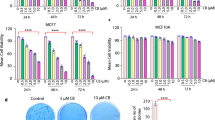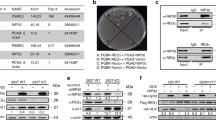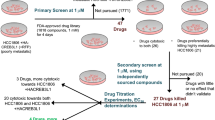Abstract
In this study we investigated the growth inhibitory effects of UCN-01 in several normal and tumor-derived human breast epithelial cells. We found that while normal mammary epithelial cells were very sensitive to UCN-01 with an IC50 of 10 nM, tumor cells displayed little to no inhibition of growth with any measurable IC50 at low UCN-01 concentrations (i.e. 0 – 80 nM). The UCN-01 treated normal cells arrested in G1 phase and displayed decreased expression of most key cell cycle regulators examined, resulting in inhibition of CDK2 activity due to increased binding of p27 to CDK2. Tumor cells on the other hand displayed no change in any cell cycle distribution or expression of cell cycle regulators. Examination of E6- and E7-derived strains of normal cells revealed that pRb and not p53 function is essential for UCN-01-mediated G1 arrest. Lastly, treatment of normal and tumor cells with high doses of UCN-01 (i.e. 300 nM) revealed a necessary role for a functional G1 checkpoint in mediating growth arrest. Normal cells, which have a functional G1 checkpoint, always arrest in G1 even at very high concentrations of UCN-01. Tumor cells on the other hand have a defective G1 checkpoint and only arrest in S phase with high concentrations of UCN-01. The effect of UCN-01 on the cell cycle is thus quite different from staurosporine, a structural analogue of UCN-01, which arrests normal cells in both G1 and G2, while tumor cells arrest only in the G2 phase of the cell cycle. Our results show the different sensitivity to UCN-01 of normal compared to tumor cells is dependent on a functional pRb and a regulated G1 checkpoint.
This is a preview of subscription content, access via your institution
Access options
Subscribe to this journal
Receive 50 print issues and online access
$259.00 per year
only $5.18 per issue
Buy this article
- Purchase on Springer Link
- Instant access to full article PDF
Prices may be subject to local taxes which are calculated during checkout







Similar content being viewed by others
References
Akiyhama T, Yoshida T, Tsujita T, Shimizu M, Mizukami T, Okabe M and Akinaga S. . 1997 Cancer Res. 57: 1495–1501.
Band V, Dala S, Delmolino L and Andropphy EJ. . 1993 EMBO J. 12: 1847–1852.
Band V, DeCaprio JA, Delmolino L, Kulesa V and Sager R. . 1991 J. Virol. 65: 6671–6676.
Band V and Sager R. . 1989 Proc. Natl. Acad. Sci. USA 86: 1249–1253.
Band V, Zajchowski D, Kulesa V and Sager R. . 1990 Proc. Natl. Acad. Sci. USA 87: 463–467.
Berns A. . 1994 Curr. Biol. 4: 137–139.
Boorne A, Donnelly N and Schrey M. . 1998 Breast Cancer Res. Treat. 48: 117–124.
Bunch R and Eastman A. . 1997 Cell Grow. Diff. 8: 779–788.
Carmichael J, Mitchell JB, DeGraff WG, Gamson J, Gazder AF, Johnson BE, Glatstein E and Minna JD. . 1988 Br. J. Cancer 57: 540–547.
Courage C, Budworth J and Gescher A. . 1995 Br. J. Cancer 71: 697–704.
Dyson N, Guida P, Munger K and Harlow E. . 1992 J. Virol. 66: 6893–6902.
El-Deiry WS, Tokino T, Velculescu VE, Levy DB, Parsons R, Trent JM, Lin D, Mercer WE, Kinzler KW and Vogelstein B. . 1993 Cell 75: 817–825.
Friend S. . 1994 Science 265: 334–335.
Gray-Bablin J, Rao S and Keyomarsi K. . 1997 Cancer Res. 57: 604–609.
Gray-Bablin J, Zalvide J, Fox MP, Knickerbocker CJ, DeCaprio JA and Keyomarsi K. . 1996 Proc. Natl. Acad. Sci. USA 93: 15215–15220.
Harbour JW, Lai SL, Whang-Peng J, Gasdar AF, Minna JD and Kaye FJ. . 1988 Science 241: 353–357.
Harper JW, Adami GR, Wei N, Keyomarsi K and Elledge SJ. . 1993 Cell 75: 805–816.
Harper JW and Elledge SJ. . 1996 Curr. Opin. Gene. Dev. 6: 56–64.
Hessling JJ, Miller SE and Levy NL. . 1980 J. Immunol. Meth. 38: 315–324.
Horowitz JM, Park S, Bogenmann E, Cheng J, Yandell DW, Kaye FJ, Minna JD, Dryja TP and Weinberg RA. . 1990 Proc. Natl. Acad. Sci. 87: 2775–2779.
Iavarone A and Massague J. . 1997 Nature 387: 417–422.
Kato J, Matsuoka M, Polyak K, Massague J and Sherr CJ. . 1994 Cell 79: 487–496.
Kawakami K, Futami H, Takahara J and Yamaguchi K. . 1996 Biochem. Biophys. Res. Comm. 219: 778–783.
Keyomarsi K, Conte D, Toyofuku W and Fox MP. . 1995 Oncogene 11: 941–950.
Keyomarsi K and Pardee AB. . 1993 Proc. Natl. Acad. Sci. USA 90: 1112–1116.
Khleif SN, Degregori J, Yee CL, Otterson GA, Kaye FJ, Nevins JR and Howley PM. . 1996 Proc. Natl. Acad. Sci. USA 93: 4350–4354.
LaBaer J, Garrett MD, Stevenson LF, Slingerland J, Sandhu C, Chou HS, Fattaey A and Harlow E. . 1997 Genes Dev. 11: 847–862.
Meijer L. . 1996 Trends Cell Biol. 6: 393–397.
Michieli P, Chedid M, Lin D, Pierce JH, Mercer WE and Givol D. . 1994 Cancer Res. 54: 3391–3395.
Orr MS, Reinhold W, Yu L, Schreiber-Agus N and O'Connor PM. . 1998 J. Biol. Chem. 273: 3803–3807.
Planas-Silva MD and Weinberg RA. . 1997 Mol. Cell. Biol. 17: 4059–4069.
Pollack IF, Kawecki S and Lazo JS. . 1996 J. Neuro. 84: 1024–1032.
Polyak K, Kato J.-Y, Soloman MI, Sherr CJ, Masasgue J, Roberts JM and Koff A. . 1994 Genes Dev. 8: 9–22.
Rao S, Lowe M, Herliczek T and Keyomarsi K. . 1998 Oncogene 17: 2393–2402.
Reznikoff CA, Yeager TR, Belair CD, Savelieva E, Puthenveettil JA and Stadler WM. . 1996 Cancer Res. 56: 2886–2890.
Schnier JB, Nishi K, Goodrich DW and Bradbury EM. . 1996 Proc. Natl. Acad. Sci. USA 93: 5941–5946.
Seynaeve C, Stetler-Stevenson M, Sebers S, Kaur G, Sausville E and Worland P. . 1993 Cancer Res. 53: 2081–2086.
Shao R, Shimizu T and Pommier Y. . 1997 Exp. Cell Res. 234: 388–397.
Sheikh MS, Li XS, Chen JC, Shao ZM, Ordonez JV and Fontana JA. . 1994 Oncogene 9: 3407–3415.
Sherr CJ and Roberts JM. . 1995 Genes Dev. 9: 1149–1163.
Soule HD, Maloney TM, Wolman SR, Peterson Jr WD, Brenz R, McGrath CM, Russo J, Pauley RJ, Jones RF and Brooks SC. . 1990 Cancer Res. 50: 6075–6086.
Takahashi I, Asano K, Kawamoto I, Tamaoki T and Nakano H. . 1989 J. Antibiot. 42: 564–570.
Takahashi I, Kobayashi E, Asano K, Yoshida M and Nakano H. . 1987 J. Antibiot. 40: 1782–1784.
Wang Q, Fan S, Eastman A, Worland P, Sausville E and O'Connor P. . 1996 J. Nat. Cancer Ins. 88: 956–965.
Wang Q, Worland P, Clark J, Carlson B and Sausville E. . 1995 Cell Grow. Diff. 6: 927–936.
Weinberg RA. . 1995 Cell 81: 323–330.
Werness BA, Levine AJ and Howley PM. . 1990 Science 248: 76–79.
Acknowledgements
We thank Dr Edward Sausville for UCN-01, Dr Vimla Band for 76NE6 and 76NE7 cell lines, Dr Donald C Porter, Dr Katherine Henrickson, Mr Christopher G Danes, and Mr Richard Harwell for the critical reading of this manuscript. We also gratefully acknowledge the use of Wadsworth Center's Molecular Immunology, Tissue Culture, and Photography/Graphics core facilities. X Chen is a fellow of the Cancer Research Foundation of America. This research was supported in part by Grant DAMD-17-94-J-4081 from the US Army Medical Research Acquisition Activity and by Grant No. R29-CA666062 from the National Cancer Institute (both to K Keyomarsi).
Author information
Authors and Affiliations
Rights and permissions
About this article
Cite this article
Chen, X., Lowe, M. & Keyomarsi, K. UCN-01-mediated G1 arrest in normal but not tumor breast cells is pRb-dependent and p53-independent. Oncogene 18, 5691–5702 (1999). https://doi.org/10.1038/sj.onc.1202948
Received:
Revised:
Accepted:
Published:
Issue Date:
DOI: https://doi.org/10.1038/sj.onc.1202948
Keywords
This article is cited by
-
Increased expression of HPV-E7 oncoprotein correlates with a reduced level of pRb proteins via high viral load in cervical cancer
Scientific Reports (2023)
-
Specific, reversible G1 arrest by UCN-01 in vivo provides cytostatic protection of normal cells against cytotoxic chemotherapy in breast cancer
British Journal of Cancer (2020)
-
CDK4/6 and autophagy inhibitors synergistically induce senescence in Rb positive cytoplasmic cyclin E negative cancers
Nature Communications (2017)
-
Tailoring to RB: tumour suppressor status and therapeutic response
Nature Reviews Cancer (2008)
-
Small-molecule cyclin-dependent kinase modulators
Oncogene (2003)



